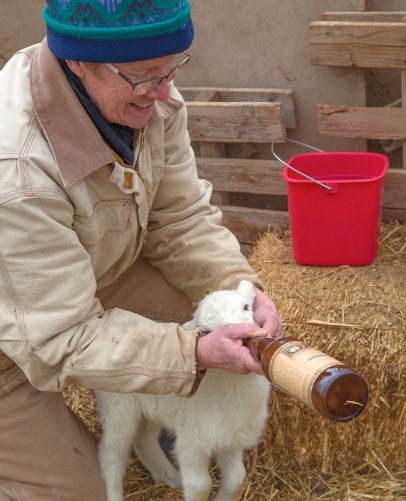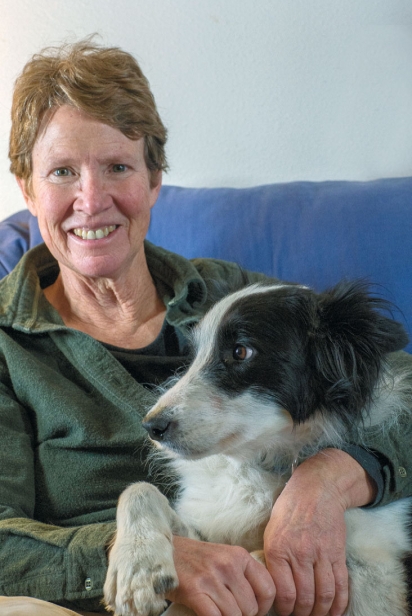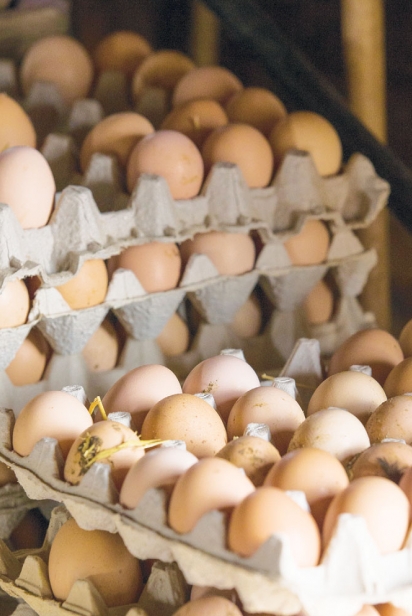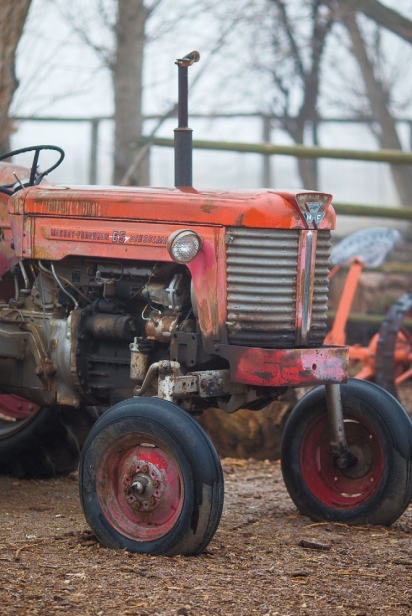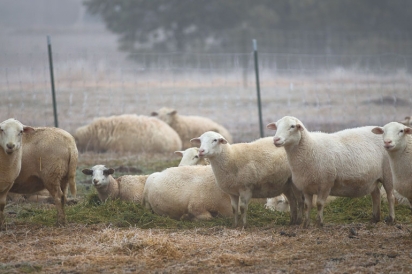Farmer, Teacher, Visionary: A Portrait of Local Food Activist Janie Burns
A cacophony of sights, sounds and rich earthy smells greets the visitor to Meadowlark Farms. Owner Janie Burns’ border collies scoot around the yard while lovely Australorp black hens strut alongside less attractive naked-neck chickens scratching at the ground, pecking bugs in the dirt.
In a nearby field, Toulouse-cross geese make a ceaseless racket. Amidst all the bah-ing, honking and barking, a sense of harmony pervades, as if Meadowlark Farm could almost run itself.
When Burns was growing up on her family’s 200-acre farm outside of Ontario, Oregon, it seemed unlikely that she would become a future leader of Boise’s local food movement. She wasn’t adept with equipment or skilled with machinery. When her dad needed a hand with the cattle or crops he would call on her two younger brothers.
“I was the help of last resort,” said Burns.
But growing up in a rural environment has shaped Burns’ values profoundly. Farm life provided her with a firsthand perspective on how American agriculture operated in the 1960s. Her dad ran registered Angus cows and planted row crops to feed them. Eggs came from the family’s chickens; vegetables from their garden.
While Burns loved the freedom of the farm, both she and her parents could see that farm jobs were disappearing. So Burns decided to pursue a pre-med degree at the College of Idaho in the 1970s. But by the time she graduated in 1977, her thinking about society, ecology and her major (now English literature) had evolved.
Burns did an eight-year stint in the Marine Corps, then returned to Idaho and settled in the town of Murphy in Owyhee County. It was there that an accidental encounter with a seed catalog changed the course of her life.
“I had been paying not one bit of attention to our food,” she said.
But then she stumbled across the Seeds Blum catalog, which represented the trailblazing efforts of Boise County–based Jan Blum. To Janie Burns’ great surprise, the catalog offered not just three or four types of lettuce, but around 30. She thought surely other people would be impressed by this diversity, so Burns decided that she would “start to grow things.”
Her enterprise began with two big questions: “Why is the genetic diversity in the seed catalog not represented in the grocery stores?” And, “Why do we need to use chemicals to grow our food when for 10,000 years we did not?” Since then, she has added a third: “Why, when we’re surrounded by food crops, aren’t we eating what’s grown right here?” looked on as wide-eyed lambs scurried about. Over the years, Burns has determined just the right number of ewes (55) that will birth the optimum number of lambs (about 80) to become the chops, roasts and racks that she sells in the community.
In addition to raising lamb, Burns also has approximately 200 chickens, mostly laying hens and a few roosters “to maintain the social balance.” Her chickens wander freely around her yard and many spill over onto her neighbor’s yard. Her hens produce around 40 dozen eggs
Burns says she originally knew nothing about marketing or sales, so she approached vegetable growing with an optimistic sense of what might play out. She raised large quantities of unusual organic lettuce from seed, believing that, “Of course someone will buy this.”
But the harsh light of reality cast a shadow on her plan. People in Murphy didn’t exactly eat vegetables in 1989, especially not kale or yellow lettuce. Envisioning piles of leftover produce, Burns had a brief panic attack. Then, she caught a news piece on KTVB announcing that the Idaho Department of Agriculture was starting a farmers market in Downtown Boise. Burns had never been to a farmers market, but told herself, “I can do this.”
Though Burns first tried having a booth at the market in Nampa, she quickly realized that, way back then, Nampa was “a head-of-lettuce and white-potato kind of town.” So she took her card table and storage containers to Boise, where she was warmly embraced.
“The Boise people were very adventuresome,” said Burns. “They had traveled.”
Boiseans were willing to buy her blue potatoes, kale and Tom Thumb lettuce. And they kept coming back. For the next two years, Burns continued selling produce at the Capital City Farmers Market and even briefly farmed land in Melba, where she says the soil was “the worst in the world.” Then in 1991 she found the acreage in Nampa that would become Meadowlark Farm.
Burns’ farm sits on 16 acres (10 are hers, six she rents) off of Southside Boulevard in an evolving section of the city where agriculture coexists with light industry and the ever-present new housing developments that have transformed this community in the state’s second- largest city.
A handsome red barn rests at the center of Meadowlark Farm. Built around 1915, the barn’s second-floor hayloft remains unfinished. After the original owner returned from World War I, he was stricken with polio and never completed the floor.
Burns’ farm seems like both a throwback to a time when raising your own food was commonplace, and a modern testament to the ideals of the local foods movement.
“I wanted to create an ecosystem that fed people,” said Burns. “To me, an agricultural ecosystem has livestock, herbivores that are eating pasture, chickens that are cleaning up all the little seeds and all the little bugs and then you have a nice diversity of food that you are growing on an annual and perennial basis within a landscape that supports all of that. And as much wild as you can do.”
Meadowlark Farm is arranged to be nearly a closed loop. This thoughtful design makes the farm look like it can operate on its own, but Burns says it still takes a lot of trial and error.
“I wanted to set up the farm so it runs itself,” said Burns. “That means being mindful of where you put the fences, where you put gates, how you set things up so you make it easy for the right things to happen. We’ve divided the farm up a lot into smaller paddocks and we’ve made the gates so we can move the sheep around rotationally in the summer.”
Some time ago, Burns transitioned from being the “lettuce lady” to “the lamb lady.” On a recent visit to the farm, dozens of ewes huddled in a long row and bleated a low moan. One self-satisfied ram, Herb, a week, but most of them are spoken for. This kind of free-range setup is hardly common in the area.
According to Burns, the state’s largest poultry operation in southeast Idaho has around one million birds. In contrast to the caged, antibiotic- filled birds raised at these giant poultry factories, Burns’ free-range chickens live as part of an ecosystem where they keep pest populations down and fertilize the ground. Burns’ customers say that the only thing uniform about her eggs is the flavor.
Locally raised produce and livestock may be appealing, but there are hard costs to getting livestock and poultry from farm to plate. Locally, we lack small-scale infrastructure—everything from canneries to freezing plants to flour mills to slaughterhouses.
To help meet this infrastructure need, Burns and a partner established a chicken processing plant in New Plymouth called Homegrown Poultry. While the plant has provided a much-needed service over the last 10 years—as of 2014, about 15,000 birds had been processed—the numbers just aren’t adding up. So Burns has decided to sell.
“I never wanted to kill chickens for a living,” she said. “That was never my goal in life.”
Whether or not it was her goal, Burns has become a leading advocate in the region for sustainable agricultural practices. She has helped bring together local producers and customers and has been a steady voice calling for the resurrection of local canning, processing and distribution infrastructure.
To Burns, community activism comes naturally. She served on the board of Sustainable Community Connections of Idaho, which promoted the Think Boise First and Think Nampa First campaigns. She cofounded the 2011 Year of Idaho Food program and chairs the Treasure Valley Food Coalition. She’s on the board of the Boise Farmers Market, which is about to open for its third season. She also works with University of Idaho extension and the College of Idaho.
One of Burns’ biggest roles is with the Treasure Valley Food Coalition (TVFC), a nonprofit that promotes a vibrant local food economy in the Treasure Valley and Eastern Oregon. The TVFC’s first task was to gather information about what foods were produced and consumed locally, so they contracted Ken Meter, who had done an illuminating study in Minnesota. He discovered that most of the food grown there was trucked out, while most of the food that locals depended on was trucked in. The same results held true for the Treasure Valley, where less than 10% of what is sold locally is raised in the region.
Burns describes the current TVFC board as “a group of middle-aged women who sit around and think about what needs to change in our food system.”
“In a sense we are kind of a think tank that does the work,” added Burns.
To encourage the public to look at local food in new ways, the TVFC initiated its Tomato Independence Project with the tagline, “Ending the tyranny of the tasteless tomato.” Burns and her cohorts at the Coalition saw the popularity of seasonal tomatoes as a way of discussing complex issues inherent in the local food system. The project captured the public’s imagination and spread the joy of raising home-grown tomatoes. It also brought Barry Estabrook, author of Tomatoland, to speak at Boise State and encouraged local restaurants to offer unique Tomato Tuesday menu items.
Burns is also actively involved with the Boise Farmers Market. Though she got her start at the Capital City Public Market more than two decades ago, Burns and a few like-minded local agrarians decided to create a second market in 2013. Burns and the other farmers who were part of the “big split” wanted to be strictly a “market for farmers,” instead of a venue for art and craft artisans to sell their wares.
“Pretty soon the art is driving the cart and their needs didn’t meet the needs of the agricultural community,” said Burns. “The farmers and the rest of the market grew apart and there was a divorce that wasn’t necessarily very pretty but it’s worked out.”
Now approaching the start of its third year, the Boise Farmers Market has expanded into an indoor space over the last two winters. Ultimately, the dream is to have a permanent building to house the market.
“The market is assembling a committee to start talking about it,” said Burns, who envisions a seven-day-a-week market with a commercial kitchen, refrigeration and facilities for education.
Throughout her long career, Burns has led by example. By growing most of her own fruit and vegetables, saving seeds and raising sheep and chickens on a sustainable farm, Burns lives the life she preaches.
“Janie’s work occurs in the classroom, in conference rooms, in the field and, perhaps most powerfully, in the one-on-one conversations that she has with thousands of area residents as they approach her booth at the Boise Farmers Market thinking that they might buy some eggs, lamb or chicken, and learning—as they talk with Janie—about the pressing issues of our time: local economies, food health and agricultural sustainability,” said Rochelle Johnson, an English and environmental studies professor at the College of Idaho.
So the next time you’re ambling through the Boise Farmers Market and you want to learn more about local agriculture, seek out Janie Burns. She’ll sell you on sustainability and probably sell you a nice rack of lamb, as well.


